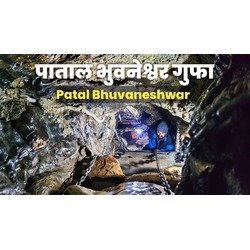Patal Bhuvaneshwar Cave Temple Pithoragarh Uttarakhand
Patal Bhuvaneshwar is a limestone Hindu cave temple 14 km from Gangolihat in the Pithoragarh district of Uttarakhand state in India. It is located in the village of Bhubneshwar. Legend and folklore have it that this cave enshrines Lord Shiva and thirty three koti demigods [33 Types, In hindu neumerology “Koti” means “Types”]. The cave is 160 m long and 90 feet deep from the point of entrance. Limestone rock formations have created various spectacular stalactite and stalagmite figures of various hues and forms. This cave has a narrow tunnel-like opening which leads to a number of caves. The cave is fully electrically illuminated. Built by the flow of water, Patal Bhuvaneshwar is not just one cave, rather a series of caves within caves.
“He who wants to feel the presence of eternal power should come to the sacred Bhuvneshwar situated near the confluence of Ramganga, Sarayu and Gupt-Ganga.” -Manaskhanda, Skanda Purana, whose 800 verses refer to Patal Bhuvaneshwar
Legend Of the Cave
The first human to discover this cave was Raja Ritupurna who was a king in the Surya Dynasty (Surya Vansha) who was ruling Ayodhya (from the time of Rama) during the Treta Yuga. The story starts with Ritupurna and King Nal. It is said that once, King Nal was defeated by his wife, Queen Damayanti. In order to escape his wife’s prison Nala requested Ritupurna to hide him. Ritupurna took him to the forests of the Himalayas and asked him to stay there. While going back home he was fascinated by a deer which ran into woods and went after it. He could not find it and took rest under a tree. He had a dream where the deer was asking Ritupurna not to chase him. His sleep broke and as he woke up and went to a cave where a guard was standing. After enquiring about the cave he was allowed to go inside. Right at the entrance, Ritupurna met Sheshnag who agreed to take him through the cave. It carried him on its hood. He saw the marvels of Gods taking place inside. He saw all the 33-koti [33 Types and not 33 Crores, In hindu numerology “Koti” means “Types”] gods and goddesses including Lord Shiva himself. It is said that after his visit, the cave was closed for ages with a slight prediction in the Skanda Purana that it will be reopened again in Kali Yuga. In the Kali Yuga, Adi Shankaracharya, during his visit to Himalayas re-discovered this cave. Since then regular worship and offering are being done at this place.
History
According to belief, King Rituparna of the Sun dynasty (Surya Vansha) discovered the cave in the Treta Yuga. In the Kali Yuga, Adi Shankaracharya visited this cave in 1191 AD. That was the beginning of the modern pilgrimage history, at Patal Bhuvaneshwar. The journey inside the cave has to be carried in feeble lights, holding protective iron chains. The Stone formations of Sheshnag can be seen, holding the earth, heaven and the underworld. ‘Havan’ (fire sacrifice) is performed in a dimly lit, solemn atmosphere, under the spell of holy chants. You’ll also be impressed by the visit as these parts form the celestial heights of Shiva’s abode in Mount Kailash. The cave, it is believed, is connected by an underground route to Mount Kailash.
It is believed that the Pandavas and their wife Draupadi, the heroes of the Mahabharata, proceeded towards their last journey in the Himalayas after meditating here, in front of Lord Shiva. This hidden pilgrimage situated at 1,350 m above sea level is mainly dedicated to Lord Shiva. Almost every god that you would have heard of resides in this mystifying cave. It is also believed that you can worship at Patal Bhuvaneshwar is equivalent to worshipping the Chota Char Dham of Uttarakhand.
The priest family, the Bhandaris are performing religious rites at Patal Bhuvaneshwar since the time of Adi Shankaracharya. More than 20 generations in the line. They are a treasure house of legends, lores, anecdotes and information about this holy place. It is also believed that this cave is internally connected to the four abodes /seats (Char Dham). According to one belief, the original human head of lord Ganesha which was cut down by lord Shiva, is situated here who creates obstacles for bad people to improve. This form of Ganesha is popularly known as Vighnaharta. The head is now not recognisable as it is covered in a layer of limestone with an 8-petaled lotus-like formation (Brahma-Kamala) on top.



















